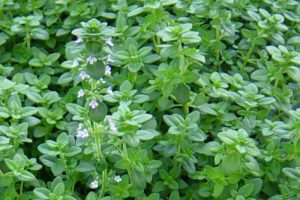
Aromatherapy is a unique and powerful branch of herbal medicine that employs the medicinal properties found in the essential oils of various plants. It is not just the aroma that provides the healing properties, as essential oils rapidly penetrate the skin, affecting the central nervous system and distant sites. “In actuality, the oils exert much of their therapeutic effect through their pharmacological properties and their small molecular size, making them one of the few therapeutic agents to easily penetrate body tissues,” says Dr. Kurt Schnaubelt, Director of Pacific Institute of Aromatherapy. Several essential oils show powerful activity against breast cancer cells in a laboratory setting.
The therapeutic properties of essential oils are diverse and multiple and should be used with discretion to achieve the desired effect and to safeguard against a toxic reaction. Certain essential oils are antibacterial, antibiotic, antiviral, antimicrobial and/or anti-inflammatory. Others can be used to energize, relax and detoxify.
In working with women with breast cancer, essential oils may be applied topically or inhaled. When applied topically, essential oils are quickly absorbed into the blood stream. Absorbency may be increased through warmth and friction. The strongest known essential oil to inhibit breast cancer cells is thyme (Thymus vulgaris), which contains carvacrol.[i] [ii] The next strongest oils safe for topical application, in descending order are chamomile (Anthemis nobilis), rose (Rose centifolia), cinnamon, jasmine (Jasminum grandiflora), lemon and curry leaf oil.
One way to compare the effectiveness of essential oils in their ability to inhibit breast cancer is to look at a reading called the IC50. The IC50 indicates how much of a particular substance is needed to inhibit a given biological process by 50%. In this case, it would be how much of an essential oil inhibits 50% survival of breast cancer cells in a laboratory setting. The lower the number, the stronger the substance. The following chart compiled by Sat Dharam Kaur ND ranks essential oils by their IC50.[i]
| Essential Oil | IC50 against MCF-7 breast cancer cells ug/ml |
| Thyme (Thymus vulgaris L.) | 0.030[ii] |
| Roman chamomile (Anthemis nobilis) | 0.072[iii |
| Rose (Rosa centifolia) | 0.074[iv |
| Cinnamon (Cinnamomum zeylanicum) | 0.076[v] |
| Jasmine (Jasminum grandiflora) | 0.077[vi] |
| Lemon (Citrus limonum) | 0.143[vii] |
| Curry leaf (Murraya koenigii) | 2.12[viii] |
| Bracelet Honey Myrtle (Melaleuca armillaris) | 12[ix] |
| Helichrysum gymnocephalum | 16[x] |
| Clove (Syzygium aromaticum) | 17.6-36.43 |
| Frankincense (Boswellia sacra) | 80 |
| Rosemary (Rosmarinus officinalis) | 190.1[xi] |
In comparison, the IC50 of the chemotherapy drug, Doxorubicin, against breast cancer cells is 250 μg/ml. The IC50 of berberine, an extract found in goldenseal is 25 μg/ml. The IC50 of pomegranate rind is 6 μg/ml.
Make Your Own Essential Oil Blend
You can make a blend of essential oils mixed in a carrier oil composed of pomegranate seed oil and olive oil. Pomegranate oil contains punicic acid, which strongly inhibits the growth of breast cancer cells. In 100 ml of carrier oil, mix 30 -50 drops of a combination of the essential oils listed above.
Before going to sleep, gently massage a small quantity into your breasts and allow the beneficial active principles to work while you are resting.
For more information about reducing breast cancer risk, or to attend a Healthy Breast workshop, see https://www.mammalive.net/workshops. Contact one of our Healthy Breast Educators here
[i] Molecules 2010, 15 3204
[ii] Zu Y, Yu H, Liang L, Fu Y, Efferth T, Liu X, Wu N. Activities of ten essential oils towards Propionibacterium acnes and PC-3, A-549 and MCF-7 cancer cells. Molecules. 2010;15:3200–10.
[iii] Zu Y, Yu H, Liang L, et al Activities of ten essential oils towards Propionibacterium acnes and PC-3, A-549 and MCF-7cancer cells. Molecules. 2010 Apr 30;15(5):3200-10
[iv] Zu Y, Yu H, Liang L, et al Activities of ten essential oils towards Propionibacterium acnes and PC-3, A-549 and MCF-7cancer cells. Molecules. 2010 Apr 30;15(5):3200-10
[v] Zu Y, Yu H, Liang L, et al Activities of ten essential oils towards Propionibacterium acnes and PC-3, A-549 and MCF-7cancer cells. Molecules. 2010 Apr 30;15(5):3200-10
[vi] Zu Y, Yu H, Liang L, et al Activities of ten essential oils towards Propionibacterium acnes and PC-3, A-549 and MCF-7cancer cells. Molecules. 2010 Apr 30;15(5):3200-10
[vii] Zu Y, Yu H, Liang L, et al Activities of ten essential oils towards Propionibacterium acnes and PC-3, A-549 and MCF-7 cancer cells. Molecules. 2010 Apr 30;15(5):3200-10
[viii] Nagappan T, Ramasamy P, Wahid MEA, Segaran TC, Vairappan CS. Biological Activity of Carbazole Alkaloids and Essential Oil of Murraya koenigii Against Antibiotic Resistant Microbes and Cancer Cell Lines. Molecules. 2011;16:9651–64
[ix] Chabir N, Romdhane M, Valentin A, Moukarzel B, Marzoug HNB, Brahim NB, Mars M, Bouajila J. Chemical study and antimalarial, antioxidant, and anticancer activities of Melaleuca armillaris (Sol Ex Gateau) Sm essential oil. J Med Food. 2011;14:1383–8.
[x] Afoulous S, Ferhout H, Raoelison EG, Valentin A, Moukarzel B, Couderc F, Bouajila J. Helichrysum gymnocephalum Essential Oil: Chemical Composition and Cytotoxic, Antimalarial and Antioxidant Activities, Attribution of the Activity Origin by Correlations.Molecules. 2011;16:8273–91.
[xi] Hussain AI, Anwar F, Chatha SA, Jabbar A, Mahboob S, Nigam PS. Rosmarinus officinalis essential oil: antiproliferative, antioxidant and antibacterial activities. Braz J Microbiol. 2010;41:1070–8.



